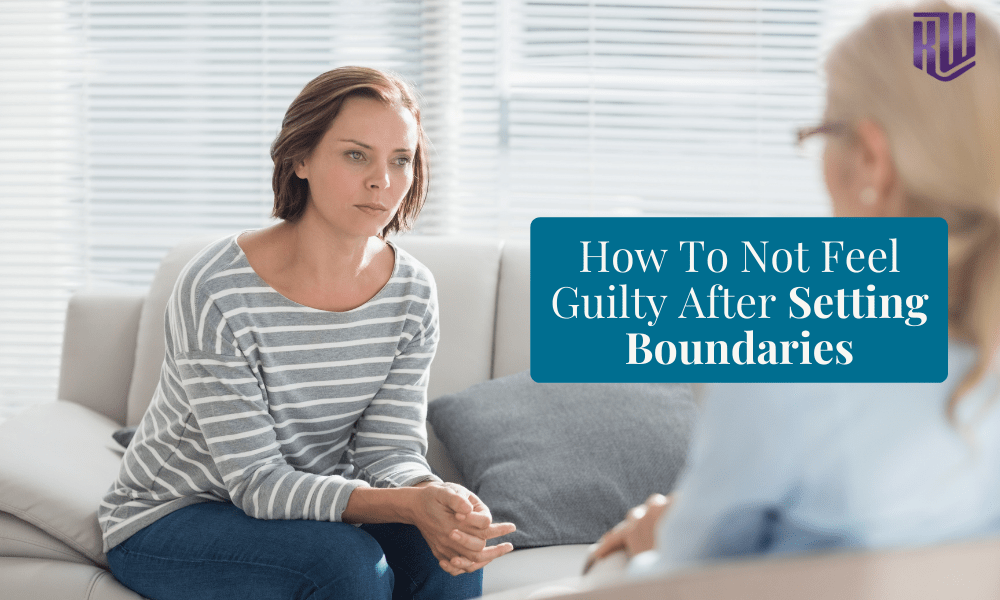Want to know how to not feel guilty after setting the boundaries you are entitled to? In today’s Best Day Blog article, I will show you how. Also, check out my YouTube video here for even more solutions.
The guilt that so many of us feel when setting boundaries is created when we try to be our authentic selves as a child, but our parents shame us. We may have been belittled, ignored, or reprimanded incorrectly? Rather than creating a healthy rule that the action we were taking was bad, they created an internal rule that we, as a person, are bad. The internal rule would say, ‘I can’t be me! If I try to be me, I am bad. I am breaking the family rules, and therefore I am a burden, defective and might lose attachment which is akin to death.’
So, we feel guilty when setting boundaries because we are not our authentic selves at that moment. Instead, we have fallen back into a child-like state. This is called our adapted wounded child.
This is what gives birth to something I discovered called The Worst Day Cycle. My book ‘Your Journey to Success’ and my Youtube Playlist titled The Worst Day Cycle will help give you even more information on this topic and how the cycle is intertwined with our loss of self.
For now, I will share the following five-step process to help you start the journey toward Emotional Authenticity. But, first, it’s time to remove the guilt from setting boundaries and reclaim your authentic self.
Step One: Identify Why We Feel Guilty
To identify our guilt, we must develop Emotional Authenticity. If you head to www.thegreatnessu.com, I am giving away the first step to developing Emotional Authenticity, my masterclass ‘Your Journey to Emotional Authenticity.’
The first thing you will learn is a process that shows you how the shame and guilt were placed on you as a child. It starts by answering the following questions whenever you contemplate setting a boundary:
- What am I feeling?
- Where in my body do I feel it?
- What is my first memory of feeling like this?
You will likely have lots of memories linked to setting boundaries. With each new memory, keep going back until you arrive at your first. You had just discovered when your parents first shamed you and, more importantly, where your Worst Day Cycle started. The awareness of these two truths makes healing achievable.
Step Two: Catalogue the Mantras
In those moments when our perfectly imperfect parents shamed us, we created mantras to minimize, justify, condone, suppress and repress the overwhelming sadness we felt. Because we need the attachment to survive, we must justify their imperfections. Unfortunately, we will use these mantras to condone poor treatment as adults.
A favorite mantra of mine came from ‘knowing’ that my father would never listen to my feelings or beliefs. Even until his death, when I considered sharing my opinion, my mantra became ‘Ah, what’s the point?’ Unfortunately, these mantras have become so ingrained they are automatic. As a result, we become entirely detached from the trauma we relive every time we repeat them. This we must heal.
Step Three: Make a Choice to Reclaim Our Authentic Self
We need to choose whether or not we are done reliving the pain against ourselves? This is a terrifying process, and it is not always easy to conquer The Worst Day Cycle. Often it will feel as though we are doing the wrong thing, going against our mantras, and even as though we might lose our parents and the people closest to us. However, we are on the way to acceptance when we recognize that the fear we experience over making this choice was created in childhood and comes from the adapted wounded child.
We can choose that it is time to be an adult, reclaim our authentic selves, and be the glorious individual we were meant to be.
Step Four: Write a Rage Letter
Growing up, we suppress who we are under the weight of the fear of abandonment and the mantras that we created to survive. We suppressed the anger, anxiety, and rage because we had to put on the ‘nice face’ to get our parent’s love. So, in this step, we need to get it out. We don’t need to send the letter to anyone. It is for the inner child to release the rage.
Because we have suppressed our God-given ability to stand up for ourselves, to set our boundaries comfortably, we need to allow ourselves, even if just in the letter, to swing the other way and put our foot down to say ‘no.’ Doing this helps you learn to self-advocate which will also improve your health.
Step Five: Give your Guilt and Shame Back
The key here is not to blame our parents because they are not to blame. They are responsible, as we must all take responsibility for our actions, but they are not to blame. It’s heartbreaking that, as a society, we are never taught how to parent or how to have relationships. Our parents had no more experience than their parents, and you’ll have no more than them. Therefore, this is a step of responsibility and not of blame.
It’s important to note that some declare, ‘I will never be like my parents, and they do the complete opposite. This does not mean they healed. Instead of discovering who they are and what type of parent they want to be, they just become the opposite of their parents. That means their parent’s shame is still controlling them. It is an adapted resentful self, not the authentic self.
Maturity is moderation – it is not in the polar extremes. So, to truly heal, we must give back the guilt and shame within us. I’ve created this playlist for you on my Youtube channel to help you navigate the difference between guilt and shame with more confidence.
Additional solutions:
1- My book, Your Journey To Success
2- My Complete Emotional Authenticity Method
3- My Perfectly Imperfect Private Group
Watch to learn more about Not Feeling Guilty:





